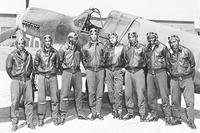An Army National Guard aviator has invented a pilot training device that partners with a smartphone app to simulate flying in limited-visibility conditions.
First Lt. Nick Sinopoli, a helicopter pilot with the Wisconsin Guard's 1st Battalion, 147th Aviation Regiment, in Madison, created the device, which consists of a visor that wraps around the pilot's face. Using a smartphone app, an instructor can cause the visor to appear cloudy and partially or fully obscure the pilot's vision, realistically simulating zero-visibility conditions that exist in fog or heavy clouds, according to a recent Army release.
It's designed to teach pilots when to transition from visual flight rules, or VFR, to instrument flight rules, or IFR, the release states.
Related: Crew of Crashed Black Hawk Became Disoriented, Army Report Says
"Simply put, IFR means relying on the instruments for control and navigation of the aircraft, while VFR requires you to be able to look outside to control the aircraft and navigate," said Sinopoli, who lost a friend to a spatial disorientation helicopter accident.
The device is among the top 16 entries in this year's National Guard Innovation Competition. Judging for the semifinal round of the competition ends Tuesday, with the final round following in June. Sinopoli's device is currently being tested at flight schools in Detroit and Hawaii and with the Federal Aviation Administration, the release states.
"Winning the National Guard Innovation Competition would create a path to getting the device into our cockpits, improving training and finally ending these tragic accidents," said Sinopoli, who sold his car to pay for the patent for the device and has spent many long nights developing prototypes, according to the release.
A flight simulator can provide similar visibility scenarios, but Sinopoli said even full-motion simulators cannot replicate acceleration forces. The pilot's inner ear senses acceleration changes, which can send conflicting information to the brain during flight, leading to spatial disorientation, the release states.
Currently, the standard practice for simulating poor visibility sometimes involves pilots putting on and taking off hoods, or an instructor putting his hand in front of the trainee's face, Sinopoli said in the release.
"It's not just bothersome; it disrupts training realism and value," said Sinopoli, who began his seven-year military career in the Navy before joining the Wisconsin Guard. "Every branch of the military flies helicopters in challenging environments. I think it would be really cool if the National Guard could lead the way on innovative weather training."
-- Matthew Cox can be reached at matthew.cox@military.com.
Read More: Student Pilots Given Unlimited Simulator Time in New Air Force Experiment













